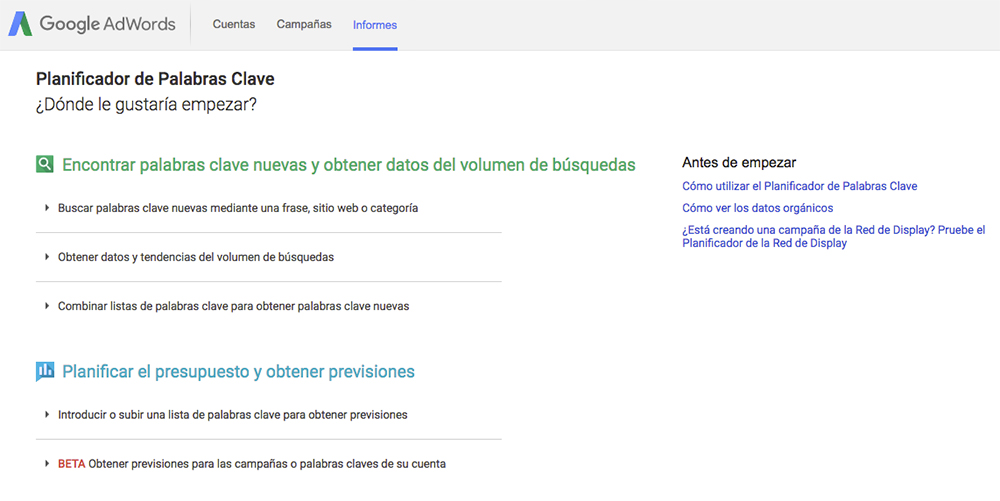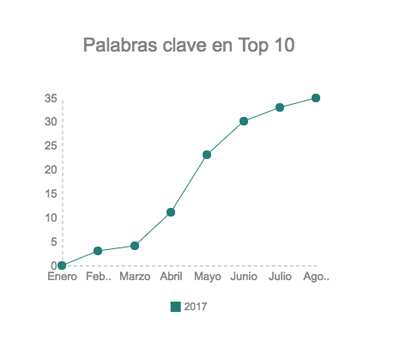Written by Rubén Martínez
Index
The blog is possibly the most widely used tool in recent years by companies with an online presence, since it promotes not only the generation of quality content within a personalized and customized environmentThe company also offers interaction with readers and bloggers, in addition to having functionalities directly associated with social networks, which favors the dissemination of publications.
One of the main goals of a blog that is attached to an existing website is to increase the visibility of the site by publishing quality content frequently, so as to reach a specific type of audience and produce recurring visits. In this article I am going to give you some ideas that will help you develop a high quality blog that will reach your target audience and awaken their interest in what you are telling them. A complete manual for running a successful blog would take considerably longer than this article, however, I will try to be as concise as I can, highlighting the most important points.
I have structured the article in 4 main blocks, as you can see in the table of contents: previous considerations, quality traffic, the time to write and the time to publish.
Preliminary considerations: hosting and content manager
The first thing we must think about is to provide ourselves with the system that will allow us to carry out the publications. Today, WordPress is a widely used tool and among its main features is that it is free, intuitive and consists of a large number of plugins that complete the functionality of any website or blog.
It is not good to make readers wait, so it is important to have a quality hosting capable of responding quickly and serving the pages in a short period of time, avoiding bounces due to slow download speed. Assuming that you have already created your WordPress page, it is time to look for those plugins that you want to use. that provide the functionalities you need, which will be mostly related to spreading the content, avoiding spam and inappropriate comments, improving efficiency, making backups, encouraging user comments, inviting subscriptions and, of course, optimizing the content for search engines, since one of the main objectives we pursue is to increase the visibility of our blog.
Review of basic ideas
Without going into details about the types of blogs that exist depending on their subject matter and the particular objectives of each one of them, let’s review some basic requirements that every blog should meet, some of which you may already be familiar with:
- Write with a consistent frequency: a blog without dynamism has its days numbered. However, an excess of publications can saturate the audience and produce a loss of leads. Better quality than quantity.
- Customized and responsive design: the look of the blog must match the rest of the web and of course adapt to mobile devices.
- Interaction with other blogs: participating in blogs related to the topic of your blog will bring you visits and comments back, especially if you manage to expand the information of the post you are commenting on. Replying to comments on your posts will show that you care about your readers.
- Links between entries: as you contribute content, it will be easy for you to build a network of internal links that will improve the navigability of the website and will distribute the popularity between the different URLs at your convenience.
- Visitor counting: include the Analytics script in the header of your blog to be able to study in detail the impact of your posts.
Quality traffic
Quality traffic is nothing more than visits that are likely to convert and knowing how to increase it is the main objective of this article. It is necessary to understand that a conversion is a very specific objective that will depend on the type of blog. A conversion in an online shoe store may mean a sale of a pair of shoes, however, for a dealership it will be more appropriate to establish as a conversion, for example, a download by a customer of a PDF with a personalized quote to buy a vehicle.
For a user to convert, in any case, you will have to show him what he is looking for, which is not always easy. Fortunately we have several tools that make it easier for us to approach with some accuracy the way people search on the Internet, such as Keywordtool.io or AdWords Keyword Planner. By making good use of any of them, you will be able to determine the types of searches you want to focus your strategy on.
Keyword research
For your publications to have a good reach through search engines, it will be essential to carry out a study of those terms related to your sector that receive more searches by Google users. Overcoming the competition is a challenge that you will have to face and, to achieve it, the first thing to do is to detect a set of keywords that will help you appear in as many search results as possible for those people who are really looking for what you can offer them.
You will not only have to consider how many impressions to achieve, but also how many of them have been clicked on, and this is where the concept of organic CTR (click-through rate on natural results) comes into play, which is directly related to the quality of the content and above all to a correct implementation of rich snippets in the blog posts. A high CTR with a good ranking is an indicator of a successful targeting of your articles to the right audience.
If you conclude this study correctly, you will have ended up with a set of keywords to attack. You can say that you already have the target, from here on what you have to do is to aim well. Let me give you an example to help you understand me better: we would not be aiming well if we wanted to position a sandals outlet category using the keyword “handmade shoes”. Basically, the content of that page will not correspond to its title, so it will not even rank and if it does, the quality of the visit will be very poor. Make sure that your keywords appear in titles, meta descriptions, Hn headers, alt of images and anchor text of links to those pages.
All keyword research must entail a subsequent analysis of the evolution of the terms in the search engine ranking, so it will be necessary to use tools that keep us up to date with the place where the web is appearing. For projects that are not too large, you can find free tools, such as Pro Rank Tracker, and for larger volumes, it would be advisable to resort to paid tools such as Rank Tracker (not to be confused with the previous one, they are different) or Advanced Web Ranking.
The importance of rich snippets
The rich snippet is the information about your site that appears in search results. The fact that it is customizable is something that you should take advantage of as they are transcendental for being responsible for capturing the attention of a user when they see your website in the search engine. At this point, it will be necessary to decide on a title and description that are equally in line with the main keyword of the current article, as well as attractive to users.
Time to write
As you may have already realized, starting to write without first carrying out a keyword analysis and a coherent structuring of the content based on the semantic environment you have defined, would be to misdirect your efforts, which would later result in a pitiful waste of time, as well as a waste of technical resources and personal effort. The most important thing to keep in mind from this point on is that the most influential factor in the success of your blog is the quality of the content you are able to offer to your readers. If you want to get quality traffic, you must offer quality content.
Be prepared to spend a lot, a lot of time
Time before writing, during writing and after writing. Content writing involves an exhaustive research of specialized, updated and interesting information, a detailed organization of the ideas you want to transmit and the moment in which you must transmit them, a search for resources to complete your posts together with their optimization (images, infographics, graphics, etc.), a distribution of internal links between the entries you have planned, a correct and coherent headings hierarchy and a correct and coherent headings hierarchy.
A long-term global strategy
To plan your articles in a schematic way, even as a graph of publications where the vertices are the articles and a series of directed edges form the links, will give you a very positive global vision of what you want your blog to be in the medium and long term. You can progressively expand this network according to your ideas or needs, adding new items to enrich your website. In addition, you will have an overview of the link network, so it will be easy for you to study the popularity juice of your blog.
The above graph is a simple example of the distribution of links between articles in a travel blog within a possible category called Cuba. Above the horizontal line is the title of the article and below it, the key words of the article. We have a main article whose main keyword is Travel to Cuba and we also have four articles that bring traffic and popularity to the first one with links to it and that deal with related terms. The most appropriate way to take advantage of the traffic achieved among all these articles is to place a call to action in the form of an offer in the main article, which is where some of the keywords with which the user is presumed to aspire to make a conversion, such as “travel to Cuba”, “travel to Cuba” and “flights to Cuba”.
I suggest you to segment the content in different thematic categories within your specialty or your sector. If the category segmentation is consistent with your semantic environment, it will not be difficult to classify your publications. A simple classification for a sports blog would be: tennis, soccer, basketball, motorcycling, handball, cycling, formula 1, skiing, triathlon, etc. A higher level classification would be: motor sports, winter sports, extreme sports, combat sports, etc.
A good idea: start by writing about generic topics and then delve into more specific concepts that will make it easier for you to create links between articles.
Writing for the reader
Google has long been able to recognize whether a content is good or bad for a reader, so you will have to offer the best of you, trying to provide a differentiating value in each of your articles with which you manage to engage the audience. Look for the best images, design the best infographics, accompany the text with tables or graphs that stimulate the reader’s vision and provide a positive reading experience. Interviews with experts in fields related to yours will bring richness and links to eBooks or Apps downloads will be a resource that you should not discard if you want to offer visitors different options.
Depending on the subject matter of your newsletters, you will be targeting a more or less specific profile of person. If we think about creating a blog about video games, we will be targeting a young person, technology lover and mainly male. On the other hand, if we are going to talk about aesthetics and cosmetics, we must be aware that we will have to adapt to an audience that will be mostly female, approximately 25 years of age and older. There will be cases where it will not be as intuitive to define such a profile.
Keyword density
Speculation about this concept has been rife in recent months and I must say that, in my view, there is no such concept. I do not consider that a minimum number of repetitions of a particular phrase within a text has to be met, as that does not define at all how much we are talking about it or at what qualitative level (and Google knows this). Writing in a natural way, focusing the descriptions on the concepts extracted from the initial keyword research and using synonyms of the main keyword to avoid repetition, will be the most coherent way to develop an article. Can you repeat keywords? No doubt, but the way to measure if you overdo it in repetitions, you must measure it yourself in a reasonable way.
A good idea: look for synonyms of the main keyword and include them in H2 and H3.
Time to publish
Here is another important point. If you don’t schedule your publications, either with the network I mentioned before or with any other system that helps you to structure them, you will probably end up writing without following a pattern, which will result in not choosing the right topics, exceeding publication deadlines, writing in a less coherent way and a poor quality distribution of internal links. This will result in readers losing interest in your articles and you will never get the increase in traffic and subscribers you are looking for. Lay the groundwork for your future maneuvers and start publishing in a staggered manner with, for example, a weekly post.
Keep the blog alive with regular improvements
The extension of old texts with new contributions and with updated and improved information is something that will refresh your blog and that Google values very positively. Doing so will mean that you are working to enrich the content you are offering to readers and this will undoubtedly bring benefits in terms of visibility.
And now, how do I handle the traffic I am getting?
Through all these steps you will have started a process that will lead you to achieve nothing less than a visible increase of visits from users really interested in your content, of which a part will become regular visitors. Knowing how to manage a high traffic rate is not easy and once you are here, you will wonder what you can do with all these visits you are getting.
This is an interesting topic that I will tell you about soon in a new article in which we will discuss more about the different types of conversions, as well as the steps to follow to increase them through your blog.


